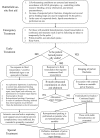Chinese expert consensus on echelons treatment of pelvic fractures in modern war
- PMID: 29970166
- PMCID: PMC6029371
- DOI: 10.1186/s40779-018-0168-3
Chinese expert consensus on echelons treatment of pelvic fractures in modern war
Abstract
The characteristics and treatment of pelvic fractures vary between general conditions and modern war. An expert consensus has been reached based on pelvic injury epidemiology and the concepts of battlefield treatment combined with the existing levels of military medical care in modern warfare. According to this consensus, first aid, emergency treatment and early treatment of pelvic fractures are introduced in three separate levels. In Level I facilities, simple triage and rapid treatment following the principles of advanced trauma life support are recommended to evaluate combat casualties during the first-aid stage. Re-evaluation, further immobilization and fixation, and hemostasis are recommended at Level II facilities. At Level III facilities, the main components of damage control surgery are recommended, including comprehensive hemostasis, a proper resuscitation strategy, the treatment of concurrent visceral and blood vessel damage, and battlefield intensive care. The grading standard for evidence evaluation and recommendation was used to reach this expert consensus.
Keywords: Classification and treatment; Combat injuries; Expert consensus; Pelvic fractures.
Conflict of interest statement
The authors declare that they have no competing interests.
Figures
References
-
- Howick J, Chalmers I, Glasziou P, Greenhalgh T, Heneghan C, Liberati A, et al. Oxford centre for evidence-based medicine 2011 levels of evidence. OCEBM Levels Evid Work Gr. 2011. Available at: http://www.cebm.net/wp-content/uploads/2014/06/CEBM-Levels-of-Evidence-2..., Accessed 22 Oct 2017.
Publication types
MeSH terms
LinkOut - more resources
Full Text Sources
Other Literature Sources
Medical


